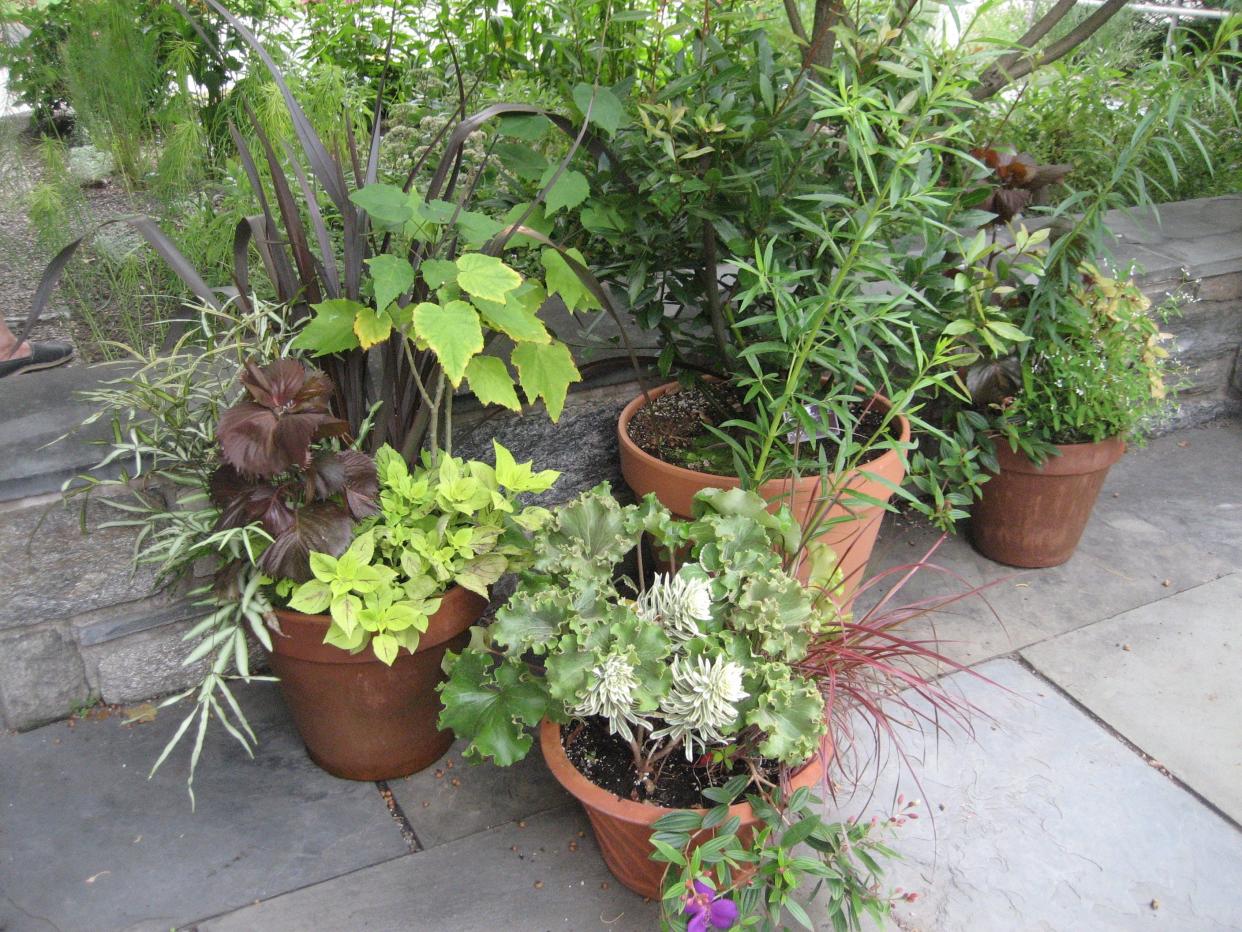Spillers, thrillers and fillers: Thinking outside the box with container gardening

Container gardening gives you flexibility. It allows you to create a garden without a yard and lets you take risks you might not take in your permanent landscape. Though I like to think of container gardening as no-rules gardening, a few guidelines will help you build a successful, stunning container display even as you think outside the box.
Containers are great for vegetables, mixed annuals or perennials, tender or tropical plants, and even some small trees and shrubs. As with in-the-ground gardening, you need to consider the light, soil, water, and nutrient requirements of the plants you are trying to grow. That said, the beauty of container gardening is that you can control these factors much more easily than you can in a static outdoor site.
More Gardening Central Mass.: Support pollinators: Don't mow your lawn!
More Gardening Central Mass.: 'As winter thaws into spring': A good time to start seeds indoors
Choose a location where your container will get the minimum amount of light recommended for the plants you are trying to grow. Most vegetables need six to eight hours of direct sunlight a day. If you are gardening on a porch or balcony that won’t get this much sun, opt for shade-loving perennials or houseplants. Plants in containers tend to dry out more quickly than those planted in the ground, so check soil moisture frequently. Many potting soil blends contain moisture holding ingredients or fertilizers that reduce the amount that you will need to water. You can also add coconut coir, a natural fiber alternative to peatmoss, or compost to increase water absorption. For nutrients, I prefer to use a slow-release fertilizer. These come in tiny beads that you can either sprinkle on the top of the soil, or more preferably mix into the media when potting up your plants.
When designing my containers, I use the tried-and-true “spiller, thriller, filler” formula. The thriller is usually a tall, upright plant that makes a statement. The filler is a mounded plant that fills the spaces in the pot and covers any soil, and the spiller is a trailing plant that will grow over the edge of the pot. I like to put unexpected combinations together, using tropicals, vegetables, and annual or perennial bedding plants in one pot. The key to making an unexpected combination work is choosing plants that have the same light, moisture, soil, and fertilization requirements. Planting cactus with a water-loving sweet potato vine might seem like a fun idea, but one of them will quickly suffer while the other thrives. One of my favorite veggies to add in mixed containers is Swiss chard (Beta vulgaris). Varieties like ‘Bright Lights’ adds a fun pop of color to your display.
Almost any type of vessel can be used for your container as long as it has enough space for roots to grow as plants mature and it has drain holes in the bottom so the soil won’t get too saturated. Glazed clay, terra cotta, or plastic pots are standards and come in many different shapes, sizes, and colors. I also love trying out galvanized bins, containers made of wood like half- barrels, or even something unexpected like a teapot.
It feels like summer when I set up my shade-loving plant containers on my covered front porch alongside my porch swing and chairs. It creates a cozy outdoor living space. In two cement urns that flank my front sidewalk, I always plant mandevilla, a sun and heat loving vine that can be trained on a trellis and has bright red or pink flowers that bloom all summer long. In my sunny backyard, I use many tropicals in mixed containers. Some of the “thrillers” in my containers are Abyssinian bananas (Ensete ventricosum ‘Maurelii’), elephant ears (Alocasia), or canna lilies (Canna). For “spillers” I use sweet potato vine (Ipomoea batatas), licorice plant (Helichrysum petiolare), or yellow creeping Jenny (Lysimachia nummularia 'Aurea'). I change up my “fillers” often using annual bedding plants, perennials, or more tropicals.
At the end of the season, I take my containers apart and pot up and overwinter tropicals or tender plants that I want to keep inside. I plant perennials in the ground and compost annual bedding plants. I then scrub my containers with soap and water and store them in my garage or basement for the next growing season.
Gardening Central Mass. is written by the team at New England Botanic Garden at Tower Hill. Located on 171 acres in Boylston, New England Botanic Garden is one of the region’s top horticultural resources. All year long, garden visitors experience the wonder of plants, learn about the natural world, and make joyful connections. There is so much growing at the garden. Discover it today at www.nebg.org. The column will be published on the third Sunday of the month.
This article originally appeared on Telegram & Gazette: Gardening Central Mass.: Getting creative with container gardening

